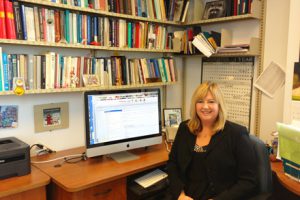
By Katherine Gombay
It’s a complaint heard all too frequently from today’s parents; kids playing video games seem to disappear into another world. But Susanne Lajoie, from the Department of Educational and Counselling Psychology, wants to harness some of that excitement and absorption and use it to improve – of all things – the way students learn.
Lajoie is the Director of the newly funded Learning Environments across Disciplines (LEADS) project. With close to $2.5 million over the next eight years from the Social Sciences and Humanities Research Council of Canada (SSHRC), LEADS brings together an international group of experts ranging from educators, psychologists and computer scientists to engineers, physicians and an historian to explore how to best use digital technology to enhance learning not only across disciplines but also across age groups, from kindergarten kids to university students.
It’s not the technology itself that interests her so much as how it can be used to help support the learning process. “Far too often, sweeping statements are made about how technology can lead to improvements in classrooms and learning in general,” says Lajoie. “To my mind technology is a tool, a means to an end. It can be designed to amplify, extend and enhance what learners know and understand. But only by introducing new cognitive learning tools into real learning situations and studying how individuals learn through them can we know how to improve their design.”
Researchers from the LEADS project will use a wide range of technology including video cameras, computers, smartphones, tablets and shared whiteboards to create learning environments where they can assess students as they interact with technology. The research runs the gamut from filming elementary school kids at play to see how they reach consensus, to creating serious video games to teach high school kids history, and even developing online diagnostic aids for medical students.
The researchers are especially interested in is using the technology to measure student engagement with learning. This is a particularly novel aspect to the research, since surprisingly little work has been done to study how a students’ interest and engagement in a particular subject affects their learning. “We can incorporate programs that read students’ faces as they use the technology to work on a specific task,” explains Lajoie. “So we can be looking for expressions of anger, joy or disgust as people get bored and fatigued and then use the technology and redirect them. Everyone has a different learning trajectory, and these technologies should be able to help us join the cognitive models with the affective models so that people are motivated to learn, whatever age or field they are in.”
It’s clear that not everyone is happy about using these new technologies. Eavesdrop on a conversation between schoolteachers these days and many of them describe feeling insecure about the computers that are increasingly present in their classrooms. Lajoie is adamant, that although the question has been coming up for years, teachers have nothing to worry about. “Technology is not going to replace teachers. Teachers have to be participants in this process rather than just having the technology imposed on them,” says Lajoie. She adds, “You need to test the technologies to see what is working and what isn’t, rather than just tell everybody to embrace them. Even though the primary goal is to make things more interactive and meaningful for the learner, the teacher can get just as excited too.”
Lajoie expects that at the end of the eight years of research, LEADS will be able to make recommendations for the best ways to use technology-rich environments to enhance student learning, engagement and assessment across disciplines and across age groups. The researchers want to figure out how digital technology can not only make learning more fun and exciting for students, but can also be tailored to meet the varied learning styles and needs of individuals, while at the same time assessing what students are thinking and feeling as they solve problems. Tools that can make it easier and more fun to learn at the same time.
